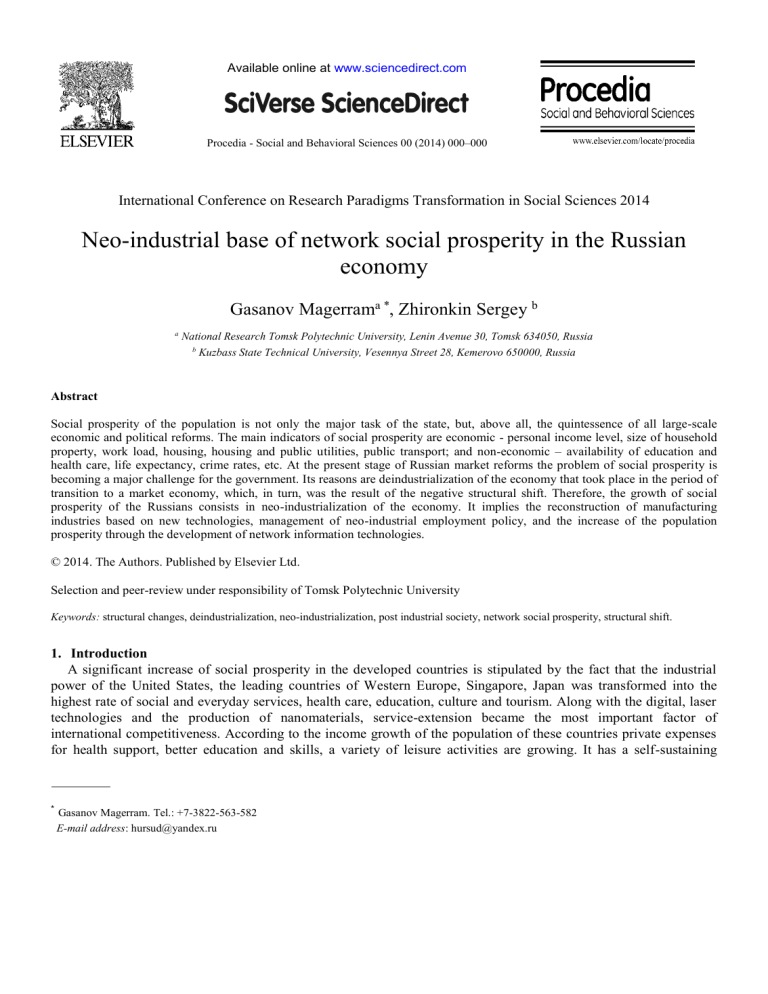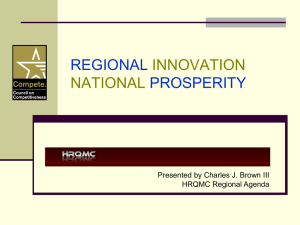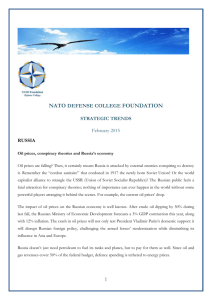Neo-industrial base of network

Available online at www.sciencedirect.com
Procedia - Social and Behavioral Sciences 00 (2014) 000–000
International Conference on Research Paradigms Transformation in Social Sciences 2014
Neo-industrial base of network social prosperity in the Russian economy
Gasanov Magerram
a *
, Zhironkin Sergey
b a National Research Tomsk Polytechnic University, Lenin Avenue 30, Tomsk 634050, Russia b Kuzbass State Technical University, Vesennya Street 28, Kemerovo 650000, Russia
Abstract
Social prosperity of the population is not only the major task of the state, but, above all, the quintessence of all large-scale economic and political reforms. The main indicators of social prosperity are economic - personal income level, size of household property, work load, housing, housing and public utilities, public transport; and non-economic – availability of education and health care, life expectancy, crime rates, etc. At the present stage of Russian market reforms the problem of social prosperity is becoming a major challenge for the government. Its reasons are deindustrialization of the economy that took place in the period of transition to a market economy, which, in turn, was the result of the negative structural shift. Therefore, the growth of social prosperity of the Russians consists in neo-industrialization of the economy. It implies the reconstruction of manufacturing industries based on new technologies, management of neo-industrial employment policy, and the increase of the population prosperity through the development of network information technologies.
© 2014. The Authors. Published by Elsevier Ltd.
Selection and peer-review under responsibility of Tomsk Polytechnic University
Keywords: structural changes, deindustrialization, neo-industrialization, post industrial society, network social prosperity, structural shift.
1.
Introduction
A significant increase of social prosperity in the developed countries is stipulated by the fact that the industrial power of the United States, the leading countries of Western Europe, Singapore, Japan was transformed into the highest rate of social and everyday services, health care, education, culture and tourism. Along with the digital, laser technologies and the production of nanomaterials, service-extension became the most important factor of international competitiveness. According to the income growth of the population of these countries private expenses for health support, better education and skills, a variety of leisure activities are growing. It has a self-sustaining
*
Gasanov Magerram. Tel.: +7-3822-563-582
E-mail address : hursud@yandex.ru
Gasanov Maherram, Zhironkin Sergey / Procedia - Social and Behavioral Sciences 00 (2020) 000–000 impact on the sphere of nonmaterial production, increasing the demand for high quality services and engaging the great masses of population in this area.
2.
Review of related research
Social development of the post- socialist countries of Eastern Europe (Slovakia, Czech Republic, Hungary,
Poland) and a number of states in South-East Asia (Singapore, South Korea, Taiwan, Malaysia) at the end of the 20th century was stipulated by the transfer of machinery, electronics , light industry, organic chemistry production here from Japan, the USA and Western Europe. Since the beginning of the 21-st century there is a new "cycle" of prosperity connected with the establishment of post- industrial society, with "new industrialization" of the economy in the developed countries of Western Europe, North America, South-East Asia.
3.
Models introduction
Russian society and state have only now come to understanding of social prosperity as the ultimate goal of market reforms, along with GDP growth, trans-nationalization of large businesses, increasing of world political influence, the integration into the system of world economic relations. For Russian people the prosperity is still an antipode of poverty (i.e. ill-being), the problem which hasn’t been solved yet in Russia, and where 13 % of the population were below the poverty line by 2013 (Dobrynina, 2013).
From the very beginning of market reforms in Russia the overcoming of the dramatic decline of social and economic conditions had been expected by means of deployment of the following processes:
Transformation of the institutional structure changing globally the public mind from "dependency mentality" on
"entrepreneurial", converting from the state administration in the economy to the support of small and mediumsized businesses, changing the mechanisms of labor motivation and incentive.
Mass privatization and widespread release of entrepreneurial initiative, the development of internal free market.
Overcoming the "socialist recession" - the restoration of economic relations, financial stabilization and "reset" of productions created in the Soviet Union due to the foreign investments.
Mainly the failure of the prosperity expectations in Russia is defined by the deformation of the labor market structure, which is far from the one in modern industrialized countries. In 2013 61% of workers are employed in unskilled or traditional labor of average difficulty in Russia. That is why it amounts to 6.4 % in industry and 7.6% in agriculture in condition of the average economic unemployment level constitutes 5.3 % at the beginning of 2014.
This greatly complicates the inter-industrial flow of labor force and, consequently, the workers’ motivation to increase productivity. New jobs created in the 2000-s do not reflect the global trend of productivity growth, wages and social protection of workers.
Scientists and managers of innovative firms are the part of highly-paid employees which in North America and
Western Europe. Their earnings exceed the earnings in industry in 1.5-2.5 times. In Russia they are paid 1.5-2 times lower than the engineers and managers of industrial enterprises. On the contrary, large part of the Russian earnings is concentrated in the administrative apparatus of the state. Another force restraining the prosperity growth of the
Russians is the criminalization of society which is a consequence of the shadow income redistribution increase. More than 17 million people were convicted in the country from 1992 to 2008 i.e. almost one in seven (Medvedev, 2009).
Thus, the existing in the Russian economy mechanisms of income redistribution through state budget and labor market institutions are able to provide prosperity for a very small group of people - the manages of monopolistic firms, high-ranking officials, financiers and criminal elements.
It cannot be ignored that financial instability, hyper inflation, default, bankruptcy and mass unemployment in the
1990-s, the refusal of the state from social guarantees of the USSR, inconsiderate privatization and social policy have the negative impact on the prosperity of the Russian. At the same time, these processes were common in this or that degree for all countries, having passed through the market transformation. We consider a negative structural shift occurred in the economy in the market reforms period to be the main reason of social prosperity decline in Russia
(Radchenko, 2008).
Gasanov Maherram, Zhironkin Sergey / Procedia - Social and Behavioral Sciences 00 (2020) 000–000
This shift obtained a form of de-industrialization i.e. the reduction of the manufacturing share in the GDP (during
1996-2012 from 48% to 34%, according to the method of the industrial production gross value), and the reduction of the processing sector in the manufacturing industry (in 2006 - 42%, in 2010 - 38 %, according to the method of add value).
The primary cause of de-industrialization in the Russian economy was the lack of government structural policy directed to the adapting the industry to new market conditions, maintaining business relations between enterprises, ensuring the flow of long-term loans and investments, retaining of scientific potential. The other causes of deindustrialization reflected spontaneous essence of an arising market: the lack of necessary market institutions, the financial crisis and the increase of speculation, high cost and lack of competitiveness in most industries, a momentary break of economic relations in the specific conditions of the industrial assets distribution in the USSR.
The cause of reduction of industrial production in Russia is in its low profitability and unattractiveness for the investors. This is due to such factors as inflation, aging of the capital stock and low productivity, deterioration of the financial state of the industrial enterprises (up to 40 % of them are unprofitable), the problems of attracting investments and skilled staff.
These de-industrialization factors of the Russian economy can be projected onto its stable social groups peculiar for the pre-industrial (extractive - before the 19th century), the industrial (manufacturing products and energy - mostly in the 20 th century) and the post-industrial (information and knowledge-based forming in the 21st century) society (by D. Bell). Despite the fact that these stages are represented in different sectors of most economies, their proportions determine the level not only technological, but also social development, and, therefore, the prosperity of the nation.
Major social groups in the pre-industrial society were farmers, merchants and landowners (from whom the officials were formed). For the industrial society major groups are highly skilled industry professionals, engineers, financial and industrial managers. Scientific workers, in fact, perform the same role as the engineers; they operate production, that’s why the possession of intellectual property does not have a significant impact on their prosperity.
Quite a different picture can be observed in the post-industrial society where basic and the most socially prosperous groups are scientists, specialists in the field of high-tech services (programmers, IT consultants, university lectures, telecommunication professionals, and doctors), workers of the advanced industries (biochemistry, photonics, robotics, nano-material manufacturing, etc.). This is largely due to the development of the intellectual capital market and intellectual rent growth.
In the Russian economy the problem of the main social groups prosperity is caused by its de-industrialization, as is evidenced by the structure of the group income distribution. Less than 20 % of the economically active population in the country are members of the most important for the industrial society social groups - engineers, skilled professionals in the field of industrial services and manufacturing, technicians and skilled workers. However, their share in the total income does not exceed 10 %. For comparison, these figures are about 40% and 50 % respectively in the United States. On the contrary, the basic social group for the Russian economy - the workers of industrial enterprises and service, employees – is up to 55 % of the employed people, and contains approximately 20% of revenues.
In Russia the social basis of the post-industrial society - scientists , innovators , IT specialists , workers of the advanced industries - is less than 1 % of the employed, and they account for less than 0.5 % of income (in the United
States these figures reach 6% and 5 % respectively) . And the most socially prosperous large groups in Russia are businessmen and officials, typical rather for the speculative promotion and pre-industrial stage.
As a result the endless circle was formed: to overcome the de-industrialization of the Russian economy there is a need for a large stable social group of highly qualified engineers, scientists and specialists of high-tech services, employees and managers of innovative firms. It is they who should be the most socially prosperous, however, in
Russia the majority of them are struggling for survival. This is kept under by the considered above structural consequences of de-industrialization , which deprive these social groups the economic basis of the prosperity - high labor productivity and surplus value, opportunities to participate in profits by drawing intellectual rent.
Gasanov Maherram, Zhironkin Sergey / Procedia - Social and Behavioral Sciences 00 (2020) 000–000
To overcome this endless circle of the structural problems of the Russian economy and to improve social prosperity it is necessary to recover the industrial production based on new technologies and to provide conditions for the gradual transition to the post-industrial economy (knowledge-based information services and the latest production technologies). All that we call neo-industrialization, the basic concepts of which we have defined as the following.
The Russian economy neo-industrialization implies, firstly, significant changes of its structure, associated with the elimination of de-industrialization consequences - by accelerating of the capital stock reproduction, activating the redistribution of investments between raw material and manufacturing industries, the integration of science and production, antimonopoly measures, technological modernization, cost reducing and increase of labor productivity.
Neo-industrialization process should also include a gradual approaching of Russian to the post-industrial economy, along with a complete industrial automation and work cybernation, intellectual capital becoming the leading factors of production, and knowledge becoming the main product, substituting import of high-tech goods and services.
Secondly, the main goal of the Russian economy neo-industrialization is a technological modernization and restoration of the processing industry, which allows significantly improve its competitiveness and investment attractiveness. To achieve that it is necessary to solve such problems as the development of clusters of competitive manufacturing industries, their raw material and resource supplying, the business involvement in investment in innovations generated in the technology platforms, the usage of money supply, credit, guarantee, investment instruments of structural policy by the state.
Thirdly, the economic condition of neo-industrialization is an implementation of the government policy, focused on bringing the proportions of factors of production, type of ownership, institutions, sectors and industries, market models and clusters in accordance with the level of technology and social standards of the post-industrial society. The neo-industrialization factors are: scientific and technical progress; vertical integration of manufacturers and processers of raw materials, R & D organizations; innovations and investments; market competition; improvement of financial reports of companies; availability of natural resources. The use of these factors requires the state to increase financing of fundamental researches; to improve the efficiency of the tax benefits for innovation companies; to promote the relations between innovators, raw materials and processing enterprises, investors and banks; to develop public and private partnerships in innovative clusters.
Fourthly, the social condition of neo-industrialization should become the formation of target social groups of advanced industrial and post-industrial society, and the result - the prosperity of all the Russian people by means of the acceleration of economic growth due to the growth of surplus value and the share of labor in the costs along with increasing of the raw material processing.
The target neo-industrial social group is an innovative class, which, along with the mechanisms of investment in innovation, must become the foundation of the Russian economy neo-industrialization. Innovative class being the main producing layer in the developed industrialized and post-industrial society include those employed in the information business, highly educated managers and employees of modern corporations, scientists and experts from industries of intangible goods. W. Clement and J. Myles note that the only effective method of improving the employees’ prosperity is the acquisition of rare skills which do not have easily available substitutes.
The formation methods of stable social groups necessary for neo-industrialization of the Russian economy should reflect its factors and include the following.
The first method includes government educational contracts for Russian specialists to study abroad in critical and edge technologies with further obligatory work placement in innovation cluster and techno-parks resident companies.
The second method means drafting of government guaranties of employment for highly professional staff and graduates specialized in critical technologies.
The third method includes all tax exemptions for wages in innovation companies, research-and-development departments, and tax exemptions for their employees’ personal incomes.
The forth method means obligatory requirement of qualified staff training for investment projects supported by
Russian Venture Company and other government funds for investment in innovations. Also it is important to legalize the norms of investment in staff training in state economic programs.
Gasanov Maherram, Zhironkin Sergey / Procedia - Social and Behavioral Sciences 00 (2020) 000–000
The edge technologies that can really help to grow social prosperity up in the Russian economy during its neoindustrialization include network technologies of generation, processing and redistribution of the information. These technologies are obtainable by the state, public companies and citizens as well. G. Kan, U. Braun and L. Martel wrote that just network technologies are able to provide rapid growth of social prosperity because scientific progress goes in intangible industries faster than in tangible ones and they can not provide target growth rates of personal incomes
(Clement, 1994).
The set of modern Internet-based social technologies is quite large and the most diffusive ones include the following:
Web design, i.e. creating the websites for small and middle scale companies, self-employers, public organizations, private customers. Modern researches showed that every sixth American adult from 15 to 50 years old made website or webpage for profitable work at least once. So we can say that the group of commercial users of web design network technologies counts to several million of modern people.
Distributed software making that means production of complex software in pieces, with every piece can be created by single specialist.
Internet-consulting, that becoming more and more popular in the USA and UK. It means providing the international customers with professional services via Internet by licensed doctors, psychologists, financial and legal counselors, computer security specialists etc. At present time we estimate potential capacity of customer network services market in Russia at least of 2 million people.
Distance private teaching foreign languages, hair, interior, home and fashion design, consulting by well-known high school teachers.
Internet-based marketing – accumulation the marketing information about wide segments of consumer goods market for large and middle-scaled commercial firms, questioning and Gallup polls making using Internet.
As we can see, the edge network technologies are completely able to involve millions of Russian people into modern ways of labor and small business. It gives the opportunity to promote the network social prosperity as its special kind which can be established only with the edge information technologies. The main characteristic of the network social prosperity is convergence – the rapprochement of the different industries in process of edge technologies’ diffusion and appearing similar motives for investment. In this case it concerns such industries as computing and information processing, global marketing and advertizing, digital equipment manufacturing.
Therefore it proves that the stimulation of innovations' global diffusion can give, on the one hand, a new impulse to the expansion of these industries. On the other hand, global diffusion of innovations can start the foundation of a new industry – multifunctional consumer network services.
The economic form of the network social prosperity constitutes the computing clusters, producing information technologies and diffusively spreading them around the world. Unlikely industrial clusters, the information ones have only their “cores” linked to the certain territory. These “cores” are the head quarters of computing centers of clusterresident companies, high schools and scientific laboratories. Other members of information clusters are spread around the world and connected to the “core” by Internet and the contracts of taking part in information products development (Raice, 2010).
The peculiarity of network informational technologies is their direct participation in prosperity growth not only in the places of their creation (IT-clusters), but later - among the wide groups of people. It requires the change of approach to the enforcement of innovations by the state. Today Russian Government attentively watches the innovation companies to receive tax exemptions only if there are residents of clusters. Practically it is difficult to receive tax exemptions for non-resident companies due to innovation clusters. This pro-fiscal economic policy primarily slows down the growth of the modern edge technologies end excludes them from the social prosperity drivers.
Therefore it is necessary to exempt the profits of investors in IT-clusters and the wages of their employees from all taxes. Also tax exemptions must be given to the freelancers, cooperating with the companies – residents of IT-
Gasanov Maherram, Zhironkin Sergey / Procedia - Social and Behavioral Sciences 00 (2020) 000–000 clusters. These exemptions must exceed the amount of profits and wages on 150%. This will certainly create additional motivation to the rise of network social prosperity.
4.
Conclusion
So the problem of Russian people social prosperity increased especially high due to national economy deindustrialization as the negative consequence of non-regulated market reforms under condition of effective structural policy. In turn the perspectives of achieving to European level of social prosperity in Russia may to come true only within condition of economy’s neo-industrializing. It means revealing the national industry using new technological bases. The main role in it belongs to the forming of steady social group – scientists, innovators, high-qualified technicians. We are highlighting the importance of the development of network-based technology clusters and the diffusion of these innovative technologies among the wide groups of people. All in all, the Government’s efforts must be focused on the development of the special form of social prosperity – the network prosperity, based on the latest progress achievements.
Acknowledgements
The author would like to thank to Galina Barisheva, Victor Kanov for their discussion during the study. We thank the anonymous referees for their constructive and useful comments on the paper.
References
Dobrynina, E. (2013) Sociologists discovered why the poverty in Russia decreased and money-seized people increased. Rossijskaja gazeta.
Federal'nyj vypusk, 6109, 12.
Uneployment in Russia in April 2014 reached 5,3% of labour-ready people. RBC, 22.05.2014. URL: http://quote.rbc.ru/news/fond/2014/05/22/34160465.html
Medvedev, J (2009). Academic seizure .
Rossijskaja gazeta, The 17 of March, 26.
Radchenko, V. (2008) Good prison. Rossijskaja gazeta , The 15 of May, 18.
Gross Domestic Product and Gross Surplus Value aggregated on economic activity. Rosstat. URL: http://www.gks.ru/free_doc/new_site/vvp/tab10.xls
Bell, D. (1973) The coming of post-industrial society. Venture in social forecasting. New York: Macmillan, 884.
Labour and Employment in Russia. (2013), http://www.gks.ru/wps/wcm/connect/rosstat_main/rosstat/ru/statistics/publications/catalog/doc_1139916801766
Clement, W. & Myles, J. (1994) Relations of Ruling: Class and Gender in Postindustrial Societies. Montreal, 270. available at
Kan, G. & Braun, U. & Martel, L. (1995) The next 200 years. Scenario for America and the other world. USA – Canada: Economics, politics and culture, 2, 96–99.
Raice, G. (2010). Network Spreads in the USA. National Technical Magazine . 8, 88-96.







